The Philippine Resistance Movement stands as a testament to the strength and resilience of its people. Throughout history, women have played central roles in shaping this struggle. Their contributions have been vital in challenging oppression and advocating for rights and equality.
From historical accounts to modern initiatives, the term “woman” encompasses diverse identities, including young girls and mothers. These individuals have faced violence and injustice, yet their courage has sparked significant change. Their involvement has not only reshaped the movement but also inspired future generations.
Today, the legacy of these women continues to influence societal progress. Their stories highlight the importance of gender equality in achieving sustainable development. This article explores their transformative impact, setting the stage for a deeper historical narrative.
Key Takeaways
- Women have been pivotal in the Philippine Resistance Movement.
- Their roles span historical and modern contexts.
- They challenged violence and fought for rights.
- Their contributions inspire ongoing societal change.
- Gender equality remains crucial for sustainable development.
Historical Overview of the Philippine Resistance
The Philippine Resistance Movement is a story of courage and defiance against oppression. From the early days of colonization to the Japanese occupation, the struggle for freedom has been marked by extraordinary acts of bravery. This section delves into the key events and background of the conflict, shedding light on the roles shaped by gender and the challenges faced by individuals.
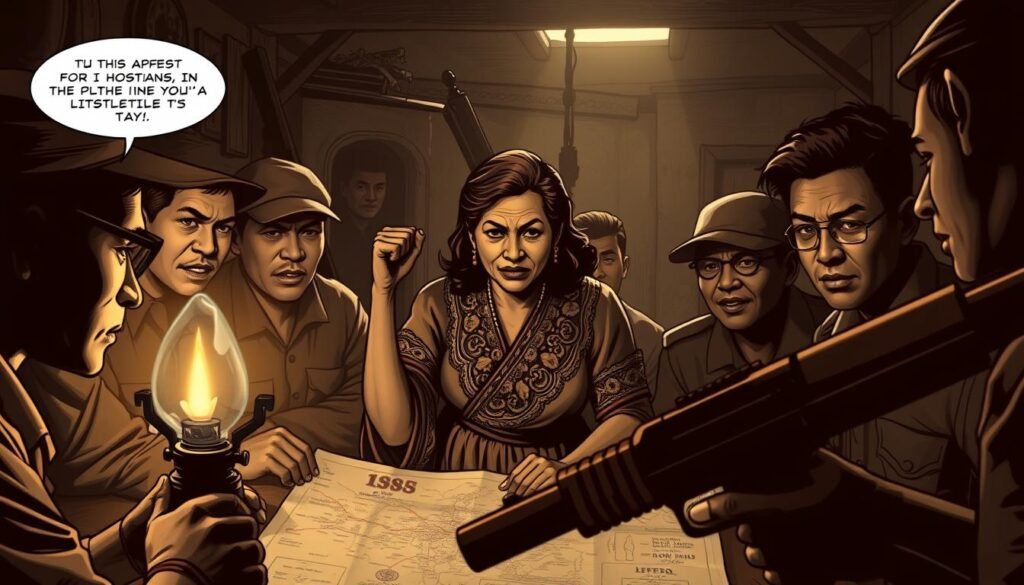
Key Events and Timelines
The resistance movement gained momentum during the Japanese occupation in World War II. Key events like the Bataan Death March and the establishment of guerrilla units highlight the resilience of the Filipino people. Over 260,000 male guerrillas participated, but historical records also show the involvement of young girls and leaders like Nieves Fernandez, who led a unit of 110 men in Leyte.
“The bounty on Nieves Fernandez’s head by the Japanese military is a testament to her impact on the resistance.”
Background of the Conflict
The conflict was not just about armed aggression but also about challenging oppressive social practices. Women faced extreme violence, including threats of rape, abduction, and even female genital mutilation. Forced marriage was another tool of control, yet many resisted and fought back. The Women’s Auxiliary Service, founded by Josefa Capistrano, became a symbol of empowerment during these dark times.
| Event | Year | Significance |
|---|---|---|
| Japanese Occupation | 1941-1945 | Marked the rise of guerrilla resistance |
| Bataan Death March | 1942 | Highlighted the brutality of the occupation |
| Women’s Auxiliary Corps | 1963 | Official recognition of women’s roles in the military |
These events and practices shaped the resistance, demonstrating the evolution of conflict dynamics. The early signs of active participation by women and young girls laid the foundation for a more inclusive movement. To learn more about the bravery of female leaders, explore the story of Teresa Magbanua, a key figure in the resistance.
Women: Empowering the Fight
Breaking barriers and challenging norms, many shaped the course of the resistance. Their leadership and courage not only advanced the movement but also paved the way for gender equality. These individuals faced immense challenges, yet their contributions remain a cornerstone of the struggle for freedom.
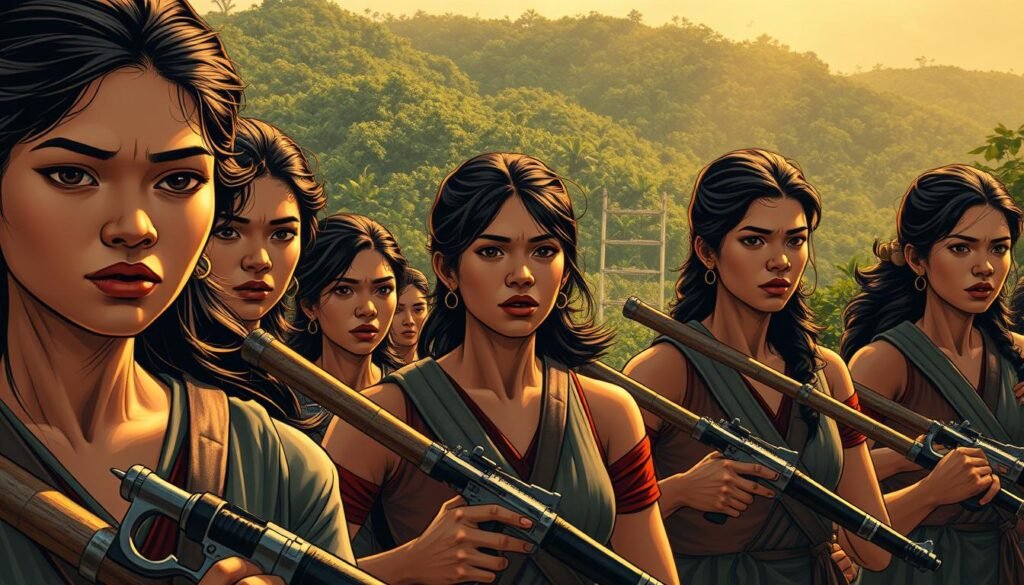
Female Heroes and Leaders
Notable figures like Nieves Fernandez and Teresa Magbanua emerged as symbols of strength. Nieves led a guerrilla unit of 110 men, while Teresa became known as the “Visayan Joan of Arc.” Their leadership inspired countless others to join the fight.
These women leveraged their unique perspectives to gain access to strategic roles. Their involvement challenged traditional norms and demonstrated the importance of inclusivity in the movement.
Breaking Gender Barriers
The resistance movement also addressed broader struggles, including issues related to female genital practices and bodily autonomy. Many faced threats of violence and forced marriage, yet they resisted and fought back.
Equality in opportunities was crucial, whether for young child recruits or mature leaders. This approach ensured that everyone, regardless of age or background, could contribute meaningfully.
“Their courage not only reshaped the resistance but also inspired global movements for equality.”
Real-life examples of empowerment, like the Women’s Auxiliary Service, became symbols of hope. These initiatives highlighted the transformative power of collective action and the enduring legacy of those who fought for justice.
Diverse Roles and Contributions
The Philippine Resistance Movement showcased the multifaceted contributions of individuals in various roles. From covert operations to healthcare, these efforts were vital in shaping the movement’s success. Their work not only countered armed violence but also addressed deeper issues like gender-based violence in its many forms.
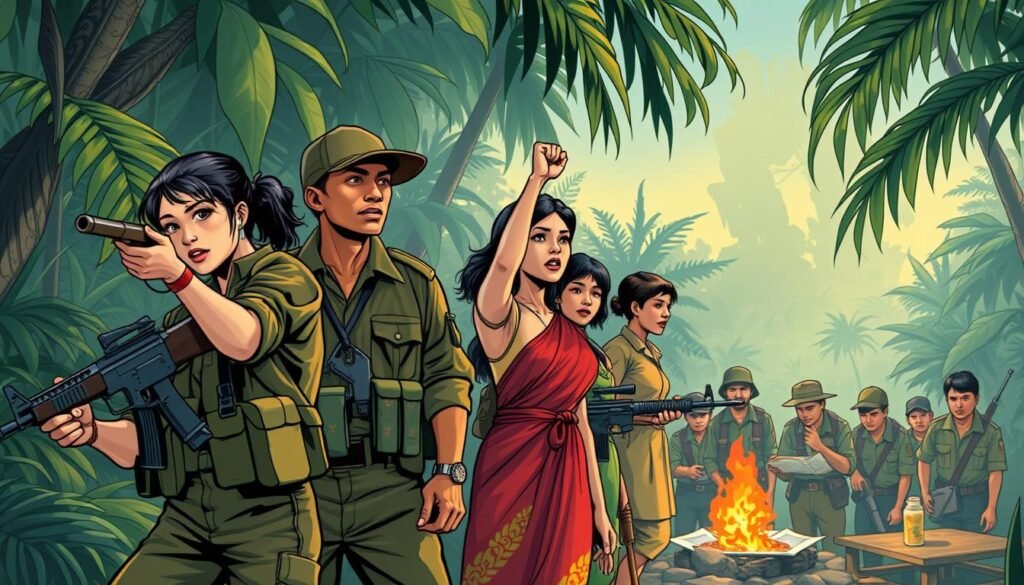
Spies, Nurses, and Strategists
Individuals took on roles that went beyond traditional expectations. Spies gathered critical intelligence, often risking their lives to provide information that shaped strategic decisions. Nurses provided essential healthcare, ensuring that fighters remained in optimal condition to continue the struggle.
Strategists played a key role in planning operations, leveraging their unique perspectives to outmaneuver opponents. These roles highlighted the importance of inclusivity and adaptability in the movement’s operational form.
International Support and Community Development
The movement also benefited from international solidarity. Organizations like UN Women provided resources and advocacy, helping to amplify the efforts of those on the ground. This support was crucial in addressing both immediate and long-term challenges.
Community development was another critical aspect. By focusing on holistic support, individuals ensured that their contributions extended beyond the battlefield. This approach fostered resilience and unity, setting a precedent for modern socio-political activism.
| Role | Contribution | Impact |
|---|---|---|
| Spies | Gathered intelligence | Shaped strategic decisions |
| Nurses | Provided healthcare | Ensured fighter readiness |
| Strategists | Planned operations | Outmaneuvered opponents |
These diverse roles not only strengthened the resistance but also challenged societal norms. Their legacy continues to inspire efforts toward equality and justice, proving that every contribution, no matter the form, is invaluable.
Women’s Tactical Innovations
Innovative strategies during the Philippine Resistance Movement highlight the ingenuity of those involved. Facing harsh conditions, many relied on adaptability and resourcefulness to outmaneuver their opponents. These tactics not only shaped the course of the war but also left a lasting legacy that remains relevant today.
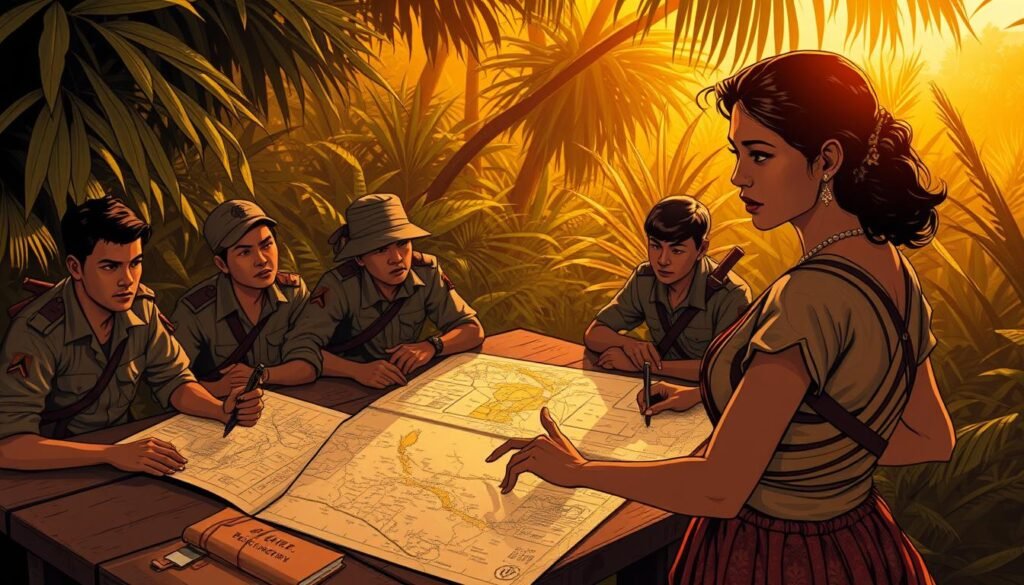
Adaptability and Improvisation in Warfare
During the conflict, individuals often had to improvise with limited resources. This adaptability was crucial in overcoming challenges posed by the war environment. For example, makeshift medical supplies and communication systems were developed to support the resistance.
In some cases, even sensitive issues like genital mutilation were addressed strategically. These efforts aimed to undermine oppressive systems and protect vulnerable communities. The ability to think creatively under pressure became a defining feature of the movement.
Organizing Underground Networks
Underground networks played a vital role in the resistance. These networks operated discreetly, gathering intelligence and coordinating efforts without detection. Their success relied on meticulous planning and the courage of those involved.
Statistical data shows that the number of individuals contributing to these networks was significant. Their work often went unrecognized, but their impact was undeniable. These networks became a cornerstone of the movement’s success.
“Their ability to organize and adapt under extreme conditions was nothing short of remarkable.”
These methods continue to inspire modern strategies, proving that resilience and innovation can overcome even the most daunting challenges. The legacy of these tactical innovations remains a testament to the enduring spirit of the resistance.
Impact of Gender Dynamics in the Movement
Challenging patriarchal norms became a cornerstone of the resistance effort. The movement not only fought for freedom but also sought to dismantle entrenched gender inequalities. This dual focus reshaped societal structures and inspired broader awareness of gender discrimination.
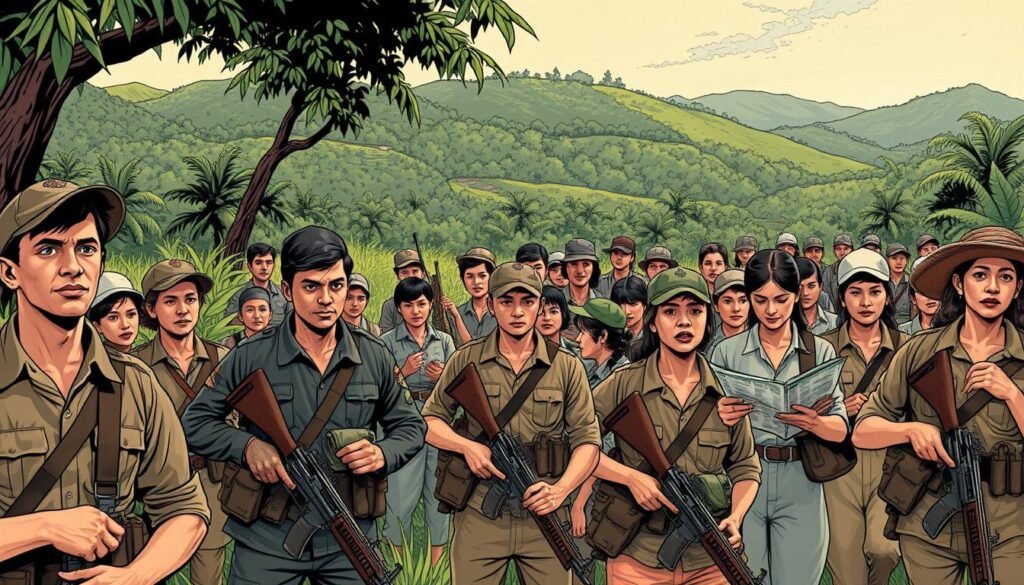
Challenging Patriarchal Norms
The resistance actively confronted traditional gender roles, empowering individuals to take on leadership and combat roles. This shift was crucial in addressing systemic sexual violence, which was often used as a weapon of war. By defying these norms, the movement set a precedent for future struggles for equality.
Comparisons with regions like Pakistan highlight the global nature of this issue. In both contexts, patriarchal systems perpetuated gender-based violence and limited opportunities. However, the resistance in the Philippines demonstrated that collective action could challenge these oppressive structures.
“The movement’s defiance of gender norms not only reshaped the resistance but also inspired global efforts for equality.”
State and non-state programme initiatives played a vital role in combating sexual violence. These efforts provided support to survivors and worked to prevent further abuses. The long-term social impact of these programs continues to be felt today, as they laid the foundation for more inclusive societies.
Understanding the intersection of gender and resistance is crucial for addressing broader issues of inequality. For more insights into how historical movements shape modern progress, explore this analysis.
Legacy of Female Resistance and Leadership
The enduring legacy of female resistance in the Philippines continues to shape leadership paradigms globally. Their courage and resilience have inspired future generations to challenge societal norms and advocate for equality. This legacy is not confined to one country but resonates across borders, influencing modern movements for justice and inclusivity.
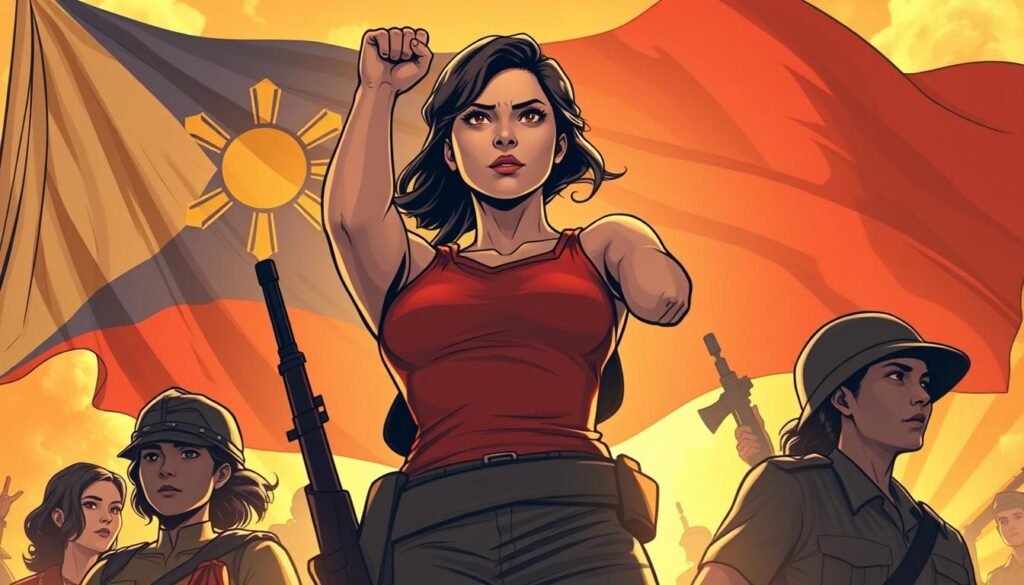
Inspiring Future Generations
The evolution of gender identity concepts was significantly influenced by the pioneering acts of many woman in the resistance. These individuals defied traditional roles, proving that leadership knows no gender. Their stories have become a source of inspiration for activists worldwide, encouraging a more balanced society.
Contrasting the roles assigned to man and many woman during the resistance highlights the shift in power structures. Women took on roles that were traditionally reserved for men, from combat to strategic planning. This shift not only strengthened the movement but also challenged deep-rooted gender biases.
“Their defiance of societal norms paved the way for a more inclusive understanding of leadership.”
Policy changes in the Philippines and other country contexts were directly influenced by these resistance efforts. For example, the increase in women’s political representation in Southeast Asia can be traced back to the groundwork laid by these pioneers. Their legacy continues to inspire contemporary movements, proving that the fight for equality is far from over.
For a deeper dive into how female leadership transformed organizational culture, explore The Role of Women in the Philippine Resistance.
Intersection of Gender Equality and Resistance
The fight for gender equality has always been intertwined with broader struggles for liberation. Across the world, feminist movements have risen to challenge oppressive systems and advocate for human rights. These efforts are not isolated but deeply connected to historical and ongoing resistance movements.
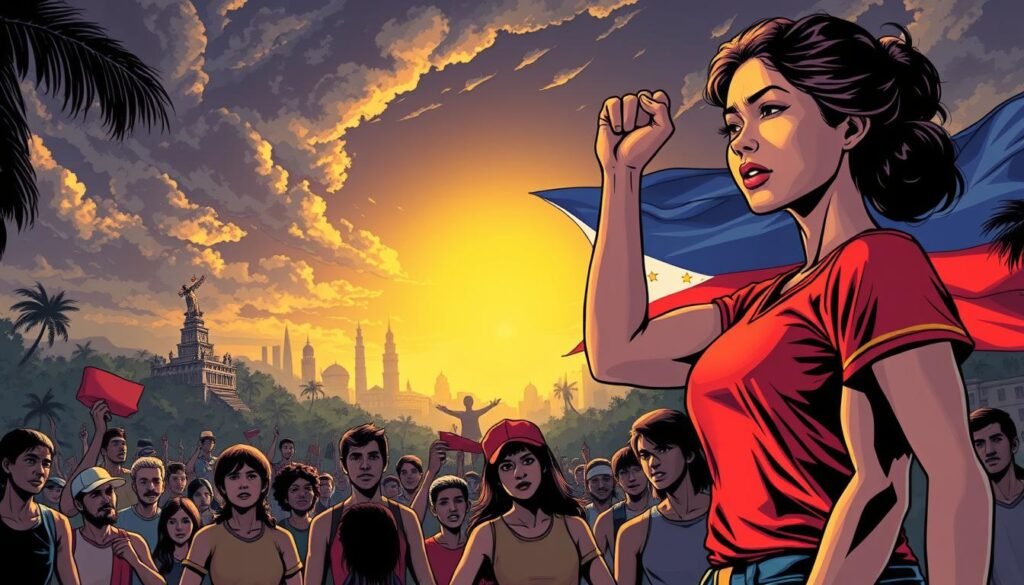
Linking Feminist Movements with Freedom Struggles
Feminist movements have played a pivotal role in shaping global resistance efforts. From the Philippines to other parts of the world, these movements have addressed issues of sex and gender, ensuring that equality remains a central goal. For example, the Women’s Auxiliary Service in the Philippines became a symbol of empowerment during the resistance.
The role of law in supporting these efforts cannot be overstated. Legal frameworks like CEDAW have provided a foundation for protecting the rights of those engaged in conflict. These laws ensure that issues like gender-based violence are addressed systematically.
“The intersection of gender equality and resistance has reshaped the fight for freedom, proving that inclusivity strengthens movements.”
Case studies from various regions highlight the interplay between local feminism and international campaigns. For instance, the work of UN Women demonstrates how global support can amplify local efforts. These initiatives underscore the importance of linking equality to long-standing freedom struggles.
By addressing issues of sex and gender, feminist movements have not only advanced human rights but also inspired broader societal change. Their legacy continues to influence modern activism, proving that the fight for equality is inseparable from the fight for liberation.
Social and Cultural Shifts Driven by the Resistance
The Philippine Resistance Movement not only fought for freedom but also sparked significant social and cultural transformations. These changes reshaped societal norms, particularly in areas like health, education, and media representation. The movement’s impact extended beyond the battlefield, influencing how communities viewed equality and empowerment.
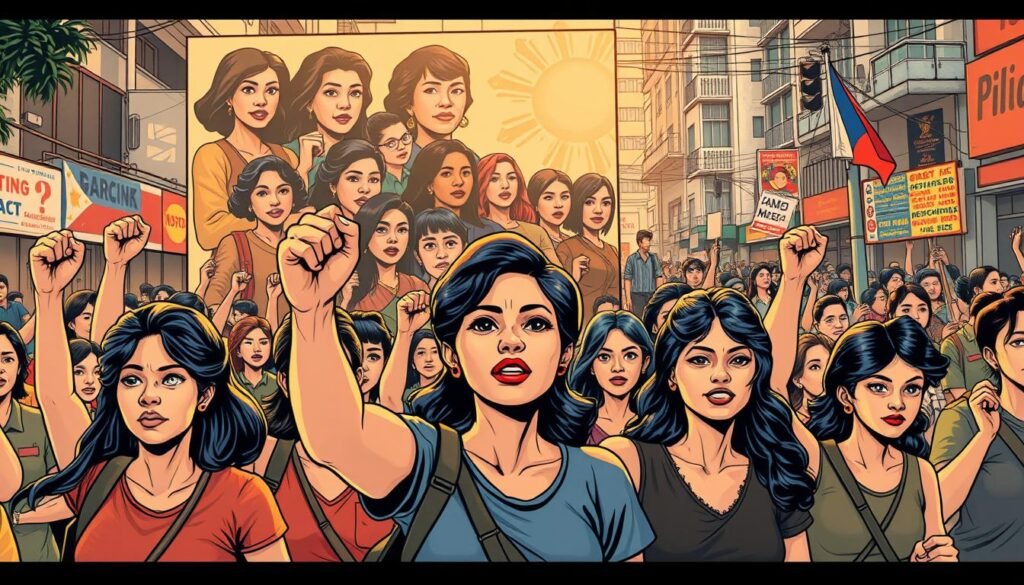
Changing Perceptions of Women in Society
As individuals took on transformative roles, societal perceptions began to shift. For example, the participation of many in leadership and combat roles challenged traditional gender norms. This shift was reflected in increased access to health services and reproductive rights, including discussions around abortion and birth control.
Media played a crucial role in amplifying these changes. Stories of courage and resilience became a source of inspiration, encouraging broader acceptance of equality. This cultural shift laid the foundation for future generations to advocate for their rights.
The Role of Media and Education
Education became a powerful tool for societal change. Schools and universities began to incorporate narratives of resistance into their curricula, fostering a deeper understanding of equality. This approach helped redefine societal expectations and encouraged inclusivity.
Media outlets also contributed by highlighting the contributions of individuals in the resistance. These representations not only honored their legacy but also inspired ongoing efforts for justice. For instance, the concept of everyday resistance gained traction, showing how small acts of defiance can lead to significant societal change.
- Social norms shifted as individuals took on non-traditional roles.
- Media and education played key roles in reshaping cultural narratives.
- Access to health and reproductive rights improved significantly.
- These changes continue to inspire modern movements for equality.
International Perspectives on Gender and Liberation
Global movements for gender liberation offer valuable insights into the Philippine Resistance. By comparing efforts across different countries, we can better understand the universal challenges and successes in achieving equality. This section explores how international campaigns have addressed issues like rape, education, and age, while highlighting the power of collaboration.
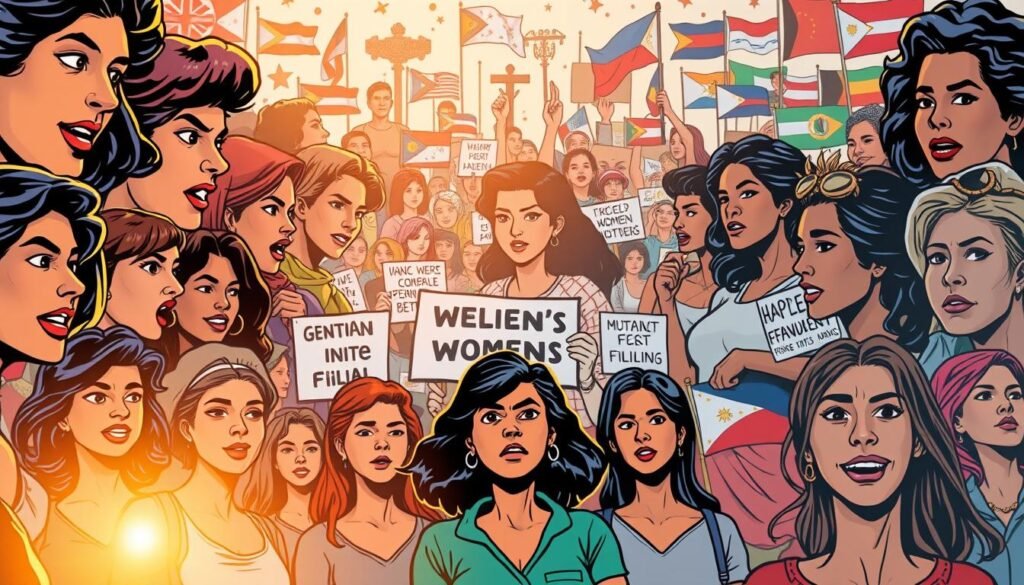
Comparative Insights from Global Movements
Initiatives by organizations like Amnesty International and UN Women have played a crucial role in addressing gender-based violence. For example, campaigns against rape in conflict zones have drawn attention to the plight of survivors across different age groups. These efforts have not only provided support but also influenced policy changes globally.
Education reform has been a key factor in promoting gender equality. In countries like Mexico, mandatory gender quotas in parliament have ensured greater representation. Similarly, the Philippines has seen progress in integrating gender equality into school curricula, fostering a culture of inclusivity from a young age.
“International collaborations have strengthened the overall movement for liberation, proving that solidarity knows no borders.”
Comparative case studies reveal varying cultural responses to gender issues. For instance, while some countries focus on legal frameworks, others prioritize grassroots activism. These differences highlight the importance of tailoring strategies to local contexts while drawing on global best practices.
| Country | Initiative | Impact |
|---|---|---|
| Mexico | Gender quotas in parliament | Increased female representation |
| Philippines | Gender equality in education | Fostered inclusivity |
| Denmark | Gender budgeting | Improved resource allocation |
These examples underscore the transformative power of international collaboration. By learning from each other, countries can strengthen their efforts toward gender liberation. For more insights into global feminist movements, explore this resource.
Conclusion
The Philippine Resistance Movement highlights the transformative power of collective action and the enduring spirit of those who fought for freedom. Throughout history, individuals have played pivotal roles, reshaping societal norms and challenging oppressive systems. Their contributions, rooted in courage and resilience, continue to inspire modern efforts for equality and justice.
Central to this legacy are themes of family, pregnancy, and the broader concept of what it means to be human. These elements have shaped identities and community roles, emphasizing the importance of individual personhood. By addressing systemic barriers, the movement laid the groundwork for a more inclusive society.
As we reflect on this history, it’s clear that the values of empowerment and equality remain vital. Building on this legacy, future generations can continue to advocate for a world where every individual’s potential is realized. For deeper insights into these themes, explore this analysis on human development and justice.
FAQ
What role did women play in the Philippine Resistance Movement?
Women were instrumental in the Philippine Resistance Movement, taking on roles as leaders, strategists, spies, and nurses. They challenged traditional gender norms and contributed significantly to the fight for freedom.
Who were some notable female heroes in the resistance?
Figures like Gabriela Silang and Teresa Magbanua emerged as key leaders. Their bravery and strategic skills inspired many and left a lasting legacy in the struggle for independence.
How did women break gender barriers during the resistance?
Women stepped into roles traditionally dominated by men, such as combat and leadership. Their participation helped shift societal perceptions and paved the way for greater gender equality.
What were some tactical innovations introduced by women?
Women excelled in adaptability, organizing underground networks, and using local resources creatively. Their innovative approaches often outsmarted the opposition and strengthened the movement.
How did the resistance challenge patriarchal norms?
By actively participating in the fight, women demonstrated their capabilities and challenged the idea that their roles were limited to domestic spheres. This reshaped gender dynamics in Philippine society.
What is the legacy of female resistance in the Philippines?
The legacy includes inspiring future generations to fight for equality and justice. Their contributions are celebrated in education, media, and cultural narratives, highlighting their pivotal role in history.
How did the resistance connect with feminist movements?
The struggle for freedom intertwined with the fight for gender equality. Women’s participation in the resistance highlighted the importance of linking liberation movements with feminist ideals.
What social changes resulted from women’s involvement in the resistance?
Women’s active roles led to a shift in societal perceptions, recognizing their capabilities beyond traditional roles. This change was further amplified through media and educational initiatives.
How does the Philippine resistance compare to global movements?
Similar to other global struggles, the Philippine resistance showcased the critical role of women in liberation movements. Comparative insights reveal shared challenges and triumphs in the fight for equality.
Source Links
- Women in the Philippines
- Women Lead The Struggle to Defend their Land, Lives and Communities in The Philippines
- Filipina Resistance Fighters: Women’s Contributions to the Liberation of the Philippines, 1942-1945
- The Female Faces of the Philippines’ Resistance
- United Nations: Gender equality and women’s empowerment
- Empowered Women Make a Difference and Change the World
- Women in the Workplace 2024: The 10th-anniversary report
- Facts and Figures: Economic Empowerment
- Propper.com: Tactical Wear, Uniforms & Gear
- Women’s Tactical Human Performance Summit 2025 – Oklahoma State University
- Women’s Tactical Boots: A Comprehensive Buying Guide!
- No title found
- Frontiers | Women in gender equality movement: a systematic literature review
- CHAPTER II. THE GENDER PERSPECTIVE
- Mátria: Women, Resistance, and the Fight for Timor-Leste’s Independence
- Intersectional feminism: what it means and why it matters right now
- Women as Agents of Change: Exploring Women Leaders’ Resistance and Shaping of Gender Ideologies in Pakistan
- Handle resistance and backlash | Spotlight Initiative
- What is Social Change?
- From women’s liberation to gender perspectives: DIIS highlights global gender issues
- Feminism – Equality, Women’s Rights, Activism | Britannica
- Conclusion on Women and Girls at Risk | UNHCR

